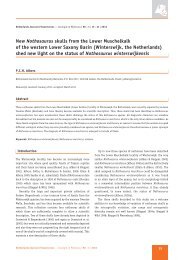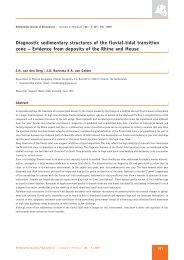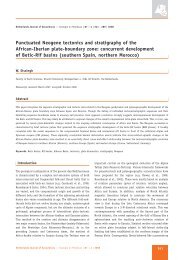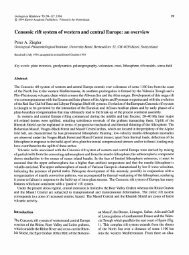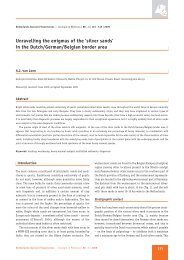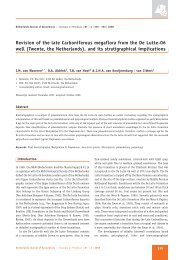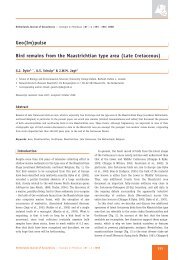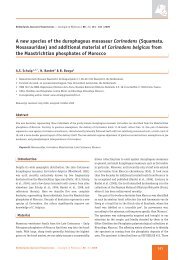Modelling of speleothems failure in the Hotton cave - Netherlands ...
Modelling of speleothems failure in the Hotton cave - Netherlands ...
Modelling of speleothems failure in the Hotton cave - Netherlands ...
Create successful ePaper yourself
Turn your PDF publications into a flip-book with our unique Google optimized e-Paper software.
Fig. 1. Localisation <strong>of</strong> <strong>Hotton</strong>.<br />
its location) is an ideal study site. It develops <strong>in</strong> Givetian<br />
limestone with sub-vertical, <strong>in</strong>verse layer<strong>in</strong>g <strong>of</strong><br />
constant orientation. The <strong>cave</strong> is <strong>the</strong> down-stream<br />
part <strong>of</strong> one <strong>of</strong> <strong>the</strong> most impressive s<strong>in</strong>k – resurgence<br />
system <strong>in</strong> Belgium. The <strong>cave</strong> <strong>of</strong> <strong>Hotton</strong> was discovered<br />
<strong>in</strong> a quarry <strong>in</strong> 1958 and was immediately closed<br />
for protection. At <strong>the</strong> present time, <strong>the</strong> <strong>cave</strong> develops<br />
5 km <strong>of</strong> galleries. Up-stream, <strong>the</strong> galleries are preserved<br />
from human depredation by a number <strong>of</strong><br />
doors and sumps.<br />
The <strong>cave</strong> <strong>of</strong> <strong>Hotton</strong> is a typical example <strong>of</strong> a multilevel<br />
<strong>cave</strong>. The different levels <strong>of</strong> <strong>the</strong> <strong>cave</strong> are l<strong>in</strong>ked<br />
with <strong>the</strong> evolution <strong>of</strong> <strong>the</strong> Our<strong>the</strong> River.The upper level,<br />
older, shows deformed and broken <strong>speleo<strong>the</strong>ms</strong>.<br />
Delaby (2000) provides field evidence that <strong>the</strong> cause<br />
<strong>of</strong> <strong>the</strong> <strong>speleo<strong>the</strong>ms</strong> break or deformation could be <strong>of</strong><br />
seismic orig<strong>in</strong>. In this study, we exam<strong>in</strong>ed candle<br />
shaped stalagmites hav<strong>in</strong>g particular morphological<br />
and environmental characteristics. The ideal shape <strong>of</strong><br />
<strong>the</strong> stalagmite is a cyl<strong>in</strong>der with a ra<strong>the</strong>r constant diameter<br />
and with <strong>the</strong> gravity centre above <strong>the</strong> base<br />
(contact po<strong>in</strong>t) <strong>of</strong> <strong>the</strong> stalagmite. The pieces <strong>of</strong> <strong>the</strong><br />
broken stalagmite must be soldered and <strong>the</strong> stalagmite<br />
must have grown on a stable substratum.<br />
The static and dynamic behaviours <strong>of</strong> <strong>the</strong> speleo<strong>the</strong>m<br />
materials have been firstly studied by laboratory<br />
test<strong>in</strong>g. With <strong>the</strong> help <strong>of</strong> <strong>the</strong> material properties and<br />
Fig. 2. Apparatus used for <strong>the</strong> bend<strong>in</strong>g tests.<br />
<strong>the</strong> <strong>in</strong>-site geometry measurement, <strong>the</strong> maximum acceleration<br />
<strong>of</strong> <strong>the</strong> earthquake which could have caused<br />
<strong>the</strong> speleo<strong>the</strong>m <strong>failure</strong> has been evaluated.<br />
Mechanical properties <strong>of</strong> <strong>speleo<strong>the</strong>ms</strong><br />
Various laboratory tests have been performed on <strong>the</strong><br />
<strong>speleo<strong>the</strong>ms</strong> taken <strong>in</strong> <strong>the</strong> <strong>Hotton</strong> <strong>cave</strong> <strong>in</strong> order to determ<strong>in</strong>e<br />
<strong>the</strong>ir mechanical properties.<br />
The mean value <strong>of</strong> <strong>the</strong> specific mass ρ <strong>of</strong> <strong>the</strong><br />
<strong>speleo<strong>the</strong>ms</strong> is 2500 kg/m 3 . The Young’s modulus E is<br />
22000 MPa. The variation around <strong>the</strong>se values is<br />
weak.The resistance <strong>in</strong> simple compression is between<br />
15 and 38 MPa, while <strong>the</strong> tensile resistance obta<strong>in</strong>ed<br />
from Brazilian tests is rang<strong>in</strong>g between 1.5 and 2 MPa.<br />
The <strong>failure</strong> tensile stress <strong>of</strong> <strong>the</strong> <strong>speleo<strong>the</strong>ms</strong> has also<br />
been evaluated by static and dynamic bend<strong>in</strong>g tests<br />
on some specimens <strong>of</strong> <strong>speleo<strong>the</strong>ms</strong> and one fatigue<br />
test has been made as well. Figure 2 and Photo 2<br />
show a schematic view <strong>of</strong> <strong>the</strong> test<strong>in</strong>g apparatus used<br />
for <strong>the</strong> bend<strong>in</strong>g tests.<br />
Seven static bend<strong>in</strong>g tests have been performed on<br />
specimens sampled from 4 broken <strong>speleo<strong>the</strong>ms</strong> (Photo<br />
1 shows <strong>speleo<strong>the</strong>ms</strong> n°5891, broken <strong>in</strong> three<br />
parts, sample 5891.1, 5891.2 and 5891.3). The tensile<br />
<strong>failure</strong> stresses deduced from <strong>the</strong>se tests are<br />
shown <strong>in</strong> Table 1.<br />
The mean value and <strong>the</strong> standard deviation <strong>of</strong><br />
<strong>the</strong>se tensile <strong>failure</strong> stresses are 1.94 and 0.71 MPa,<br />
Table 1.Tensile <strong>failure</strong> stresses from static bend<strong>in</strong>g tests.<br />
Sample Failure stress [MPa]<br />
A1 0.64<br />
A3.1 2.73<br />
A3.2 2.75<br />
B3.1 2.10<br />
B3.2 1.44<br />
5891.1 2.32<br />
5891.2 1.63<br />
5891.3 1.91<br />
50mm<br />
L<br />
Plaster<br />
Steel plate<br />
Specimen<br />
316 Ne<strong>the</strong>rlands Journal <strong>of</strong> Geosciences / Geologie en Mijnbouw / 80(3-4) 2001<br />
P



